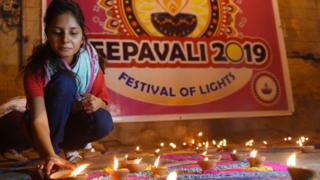 Image copyright Getty Images
Image copyright Getty Images The Indian government has introduced a controversial bill offering citizenship to illegal immigrants from three neighbouring countries if they belong to non-Muslim minority groups.
Hindus, Sikhs, Buddhists, Jains, Parsis and Christians who have entered India illegally can apply for citizenship if they can prove they originate from Muslim-majority Pakistan, Bangladesh or Afghanistan.
Getty
This bill only intends to provide protection to the persecuted minorities in Pakistan, Afghanistan and Bangladesh.
The government argues that minorities in those countries are dwindling, and that they face persecution on the grounds of their faith.
The legislation has been criticised as discriminatory as it won’t offer citizenship to other minority groups.
So what is the situation facing non-Muslims in those three neighbouring states?
How many non-Muslims?
Amit Shah, India’s Home Minister, says Pakistan’s non-Muslim population has dwindled dramatically since 1951.
This follows the mass exodus of non-Muslims from Pakistan after partition in 1947, and the flight of Muslims from India to Pakistan.
Mr Shah cites a remaining minority population in Pakistan of 23% in 1951, which he says has shrunk over the decades due to persecution.
But Mr Shah’s figures need to be challenged as he appears to have incorrectly combined the data for what is now the state of Pakistan with that of Bangladesh (formerly east Pakistan).
Census data shows that the Hindu population of Pakistan (formerly west Pakistan) has not really changed significantly from its 1951 level of around 1.5 to 2%.
The census also suggests that the non-Muslim population of Bangladesh has fallen from around 22% or 23% in 1951 to around 8% in 2011.
So, a significant fall in Bangladesh’s non-Muslim population, but a very low and stable minority in Pakistan.
There are other non-Muslim religious minorities in Pakistan and Bangladesh, such as Christians, Buddhists, Sikhs, and Parsis. And in Pakistan, there are also Ahmadis, who were declared non-Muslim by the government in the 1970s, and are estimated to be around four million strong, making them the largest religious minority in the country.
In Afghanistan, non-Muslim groups include Hindus, Sikhs, Bahais and Christians, and make up less than 0.3% of the population. In 2018, there were just 700 Sikhs and Hindus left in Afghanistan as families had been leaving because of the conflict there, according to a report for the US State Department.
What’s the official status of non-Muslims?
The Indian government’s citizenship bill states: “The constitutions of Pakistan, Afghanistan and Bangladesh provide for a specific state religion. As a result, many persons belonging to Hindu, Sikh, Buddhist, Jain, Parsi and Christian communities have faced persecution on grounds of religion in those countries. “
It’s true that the state religion of Pakistan is Islam. Afghanistan is also an Islamic state.
In Bangladesh the situation is more complicated. The country came into being in 1971 with a secular constitution, but in 1988 Islam was made the official state religion.
A lengthy legal battle to get that reversed ended in 2016 when Bangladesh’s top court ruled that Islam should remain the state religion.
However, all these countries have constitutional provisions stating that non-Muslims have rights and are free to practise their faith. And individual Hindus have risen to prominent positions in both Pakistan and Bangladesh, notably as chief justices in the two countries.
Do the minorities face discrimination?
In practice, non-Muslim minorities do face discrimination and persecution.
Human rights group Amnesty International has pointed to Pakistan’s blasphemy laws, which it says “are vaguely formulated and arbitrarily enforced by the police and judiciary in a way which amounts to harassment and persecution of religious minorities”.
Pakistani Hindus who moved to India in recent years told the BBC they face social and religious discrimination, with a particular issue being the targeting of Hindu girls in Sindh province.
But it’s also true that Ahmadis, who are not covered by India’s citizenship bill, face discrimination for their beliefs as they are regarded as heretical by the Muslim majority.
And the majority of blasphemy cases up to 2018 had been filed against other Muslims and Ahmadis, not against Christians or Hindus.
In Bangladesh, there are various reasons for the decline in the proportion of Hindus over the years. The better-off Hindu population have had their homes and businesses targeted, sometimes in attempts to get them to leave so their land or assets can be taken over. Hindus have also been the targets of attacks by religious militants.
The Bangladesh government has rejected India’s claims about minorities being targeted. Foreign Minister Abdul Monem told the BBC: “We don’t have examples of minorities being persecuted in this country.”
UN data does show the number of refugees in India going up by 17% between 2016-19. As of August this year, the biggest numbers registered with the UN were from Tibet and Sri Lanka.
Click Here to Visit Orignal Source of Article https://www.bbc.co.uk/news/world-asia-50720273

